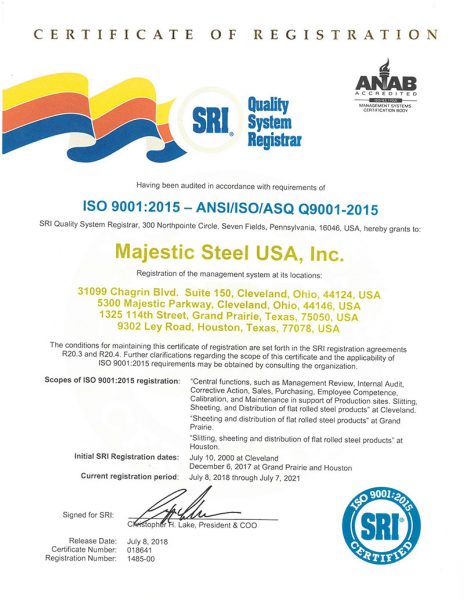Market Update | May 25, 2022
DOMESTIC PRODUCTION INCREASES AS IMPORTS PULL BACK
Domestic raw steel production climbed for the third consecutive week, but is still down 1.8% compared to the same timeframe last year. At the same time, after increasing in March, preliminary carbon steel imports for April saw the start, of what is anticipated to be, a decent pull back in carbon steel imports.
Input Costs
After sliding last week, zinc pricing rebounded some this week.
-
-
Zinc pricing is currently at $1.70/lb, a still elevated level.
-
Spot iron ore pricing increased slightly this week, climbing to $135.95/mt.
-
- Spot iron ore pricing is now flat (+0.1%) m/m but still 27.8% below prior year levels.
- Spot iron ore pricing remains near its lowest level since late January as demand concerns continue as China’s strict COVID lockdowns are affecting both production and demand.
Pacific basin met coal pricing was virtually flat this week, holding at $518.50/mt.
-
- Pricing is down 1.3% from this time last week but up 1.5% from this time last month.
Weekly U.S. import pig iron pricing slipped again this week, slipping to $867/mt, down from $890/mt last week and a recent peak of $1,030/mt in late March.
-
-
Cheaper imports from India and the first cargo booked from Ukrainian, since the Russian invasion started, helped to push pricing lower of late.
-
Despite the recent decline, the premium of pig iron pricing to domestic prime scrap pricing remains extremely elevated, compared to the 10-year average.
-
Supply
Domestic raw steel production increased slightly last week, climbing for the third consecutive week.
-
- U.S. steelmakers produced 1.789 million tons at an 82.0% utilization rate.
- Despite the recent rebound, YTD production is now down 1.8% compared to the same timeframe last year.
After increasing in March, preliminary carbon steel imports for April saw the start, of what is anticipated to be, a decent pull back in carbon steel imports.
-
-
Total carbon steel imports totaled 2.065 million tons in April, down 13.2% from March and up a slight 2.5% from April 2021.
-
Carbon flat rolled imports declined as well on a month-over-month basis, sliding 18.8%from March to 658,603 tons.
-
This is the second lowest monthly total (behind only February) since May 2021.
-
All three flat rolled product groups saw a month-over-month decline, with hot rolled imports (-26.7%) sliding the most.
-
Year-to-date carbon flat rolled imports remain elevated however, now up 48.5% compared to the same timeframe last year.
-
.
DEMAND
After climbing the previous three months, U.S. light vehicle production dipped in April.
-
-
U.S. light vehicle production totaled 769,413 units, down 15.9% from March.
-
However, production was up 8.5% from 709,281 units in April 2021, marking the first year-over-year increase since last June.
-
Year-to-date light vehicle production is now down 0.7% compared to the first four months of 2021.
-
New home sales declined sharply in April, sliding to its lowest monthly pace since April 2020.
-
-
New home sales came in at a 591,000 unit rate, down 16.6% from March and down a sharp 26.9% from an 809,000 unit rate in April 2021.
-
This is the fourth consecutive month in which new home sales have declined on a seasonally adjusted rate.
-
The median home price increased sharply once again, climbing to a fresh record high of $450,600.
-
This is up nearly 40% from the median price of $376,600 last April.
-
The inventory of new homes for sale increased as well in April, now climbing for the second consecutive month.
-
Record high housing pricing and climbing mortgage rates helped slow new home sales in April.
-
ECONOMIC
The U.S. dollar continues to push higher and is closing in on a historic moment.
-
-
The strength of the U.S. dollar, combined with the ongoing issues in Europe have caused the USD and Euro to reach near-parity; something that has not happened since 2002.
-
The strengthening dollars has numerous impacts on the market, such as, weaker commodity prices and cheaper imports.
-
This material, information and analyses (the “Content”) may include certain statements, estimates and projections prepared with respect to, among other things, historical data and anticipated performance. Content may reflect various assumptions by Majestic Steel USA, Inc. concerning anticipated results that are inherently subject to significant economic, competitive and other uncertainties and contingencies and have been included for illustrative purposes. Content is provided AS-IS.

